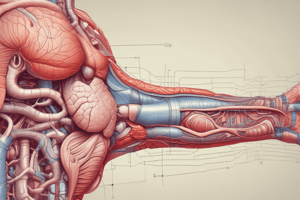Podcast
Questions and Answers
What prevents the bolus from entering the trachea?
What prevents the bolus from entering the trachea?
- Epiglottis (correct)
- Sphincter muscle
- Esophageal sphincter
- Pharynx
What part of the mouth provides mechanical digestion?
What part of the mouth provides mechanical digestion?
- Teeth (correct)
- Pharynx
- Palate
- Tongue
What is the function of the esophagus?
What is the function of the esophagus?
- To break down food into smaller pieces
- To absorb nutrients from food
- To transport food from the pharynx to the stomach (correct)
- To mix food with gastric juice
What is the common passageway for digestion and respiration?
What is the common passageway for digestion and respiration?
What is the muscle that separates the esophagus and stomach?
What is the muscle that separates the esophagus and stomach?
What do you call the food being lubricated and chewed, which forms a ball-shaped mass?
What do you call the food being lubricated and chewed, which forms a ball-shaped mass?
What is the function of the stomach in the digestive process?
What is the function of the stomach in the digestive process?
What is the primary component of gastric juice that protects the stomach lining from acid?
What is the primary component of gastric juice that protects the stomach lining from acid?
What is the name of the inner folds found in the stomach?
What is the name of the inner folds found in the stomach?
What is the result of the stomach's churning action on food?
What is the result of the stomach's churning action on food?
What is the purpose of the sphincter muscles on both sides of the stomach?
What is the purpose of the sphincter muscles on both sides of the stomach?
What is the name of the finger-like organ located in the small intestine?
What is the name of the finger-like organ located in the small intestine?
What is the primary function of the digestive system?
What is the primary function of the digestive system?
Which phase of digestion involves the breakdown of food into small pieces through chewing or mastication?
Which phase of digestion involves the breakdown of food into small pieces through chewing or mastication?
What is the role of the tongue in the mouth or oral cavity?
What is the role of the tongue in the mouth or oral cavity?
What is the primary function of the esophagus in the digestive system?
What is the primary function of the esophagus in the digestive system?
What is the purpose of the salivary glands in the digestive system?
What is the purpose of the salivary glands in the digestive system?
What is the primary function of the stomach in the digestive system?
What is the primary function of the stomach in the digestive system?
Flashcards are hidden until you start studying
Study Notes
The Mouth
- The palate forms the roof of the mouth, divided into the hard palate (anterior portion) and soft palate (posterior portion).
- The mouth provides mechanical digestion through the action of teeth breaking down food into small pieces.
The Pharynx or Throat
- The pharynx is a common passageway for both digestion and respiration, located at the back of the mouth, and is about 5-6 inches long.
- The pharynx has a sphincter muscle that covers the esophagus, allowing air to enter the trachea freely.
- The epiglottis prevents the bolus (food) from entering the trachea.
The Trachea
- The trachea is a long tube that connects the larynx (voice box) to the bronchi, which send air to the lungs.
- The trachea is a key part of the respiratory system.
The Esophagus
- The esophagus is a muscular tube that transports food from the pharynx to the stomach through a wave-like contraction called peristalsis.
- The esophageal sphincter is a muscle that separates the esophagus and stomach.
The Stomach
- The stomach is a muscular, elastic, and pear-shaped organ that stores swallowed food, mixes it with digestive juice, and conveys its contents slowly into the small intestine.
- The stomach has three functions: storing food, mixing it with digestive juice, and conveying its contents to the small intestine.
- The stomach has inner folds called rugae, which contain gastric glands that produce gastric juice.
- Gastric juice is composed of secretions from different cells, including mucous cells, parietal cells, chief cells, and G-cells.
- The stomach mixes food with gastric juice through contractions, turning it into chyme, a semifluid, partly digested food.
The Small Intestine
- The small intestine is where most of the nutrient absorption takes place.
- The finger-like organ located in the small intestine is called a villus.
Digestive System
- The digestive system has two main parts: the alimentary tract and accessory organs.
- The alimentary tract consists of the mouth, pharynx, esophagus, stomach, small and large intestines, rectum, and anus.
- The accessory organs are the salivary glands, liver, gallbladder, and pancreas.
- The digestive system has two phases: mechanical digestion (breaking down food into small pieces) and chemical digestion (breaking down food into nutrient molecules using enzymes).
- The functions of the digestive system are to ingest food, break it down into nutrient molecules, absorb molecules into the bloodstream, and rid the body of indigestible remains.
Studying That Suits You
Use AI to generate personalized quizzes and flashcards to suit your learning preferences.




